Text
Current status of ‘Same Old Art’

O.T. (no.139), 11″ x 14″, oil on paper, 2019
It has been quiet here for the past few months and the main reason is that I am busy making art which leaves me very little time to write. But that does not mean that I am not writing at all. You can read my most recent contribution here:
1. Hyperallergic
2. The New Art Examiner (there will be more of my writing in this magazine in the near future)
And if you are curious to see what I have been up to in terms of art-making, take a look here:
1. viktorwitkowski.com
And here:
2. https://vimeo.com/viktorinvermont
And if that is not enough, you can also follow me on Instagram under: @viktorLwitkowski
I think that’s more than enough links for today. Hope to see of you on the other platforms and always feel free to shot me a message.
Thanks,
Viktor
6 notes
·
View notes
Photo

Huang Hai-Hsin, Silent Night, oil on canvas, 2013
Currently on view at the Mori Art Museum in Tokyo.
15 notes
·
View notes
Photo
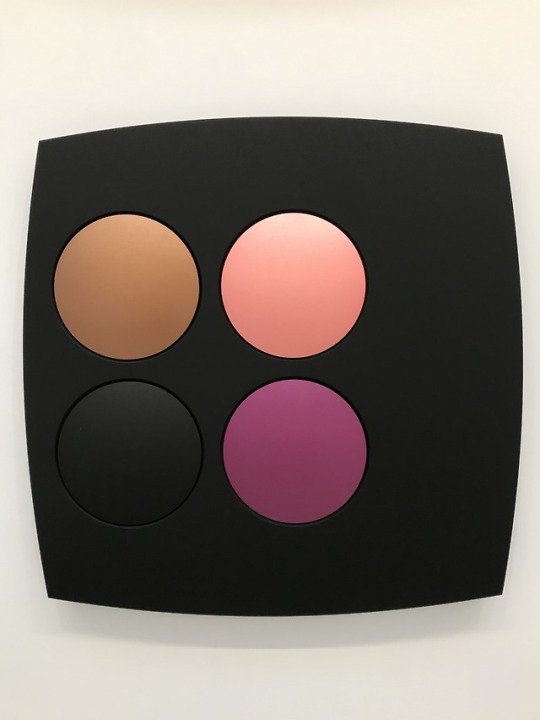
Painting by Sylvie Fleury at Thaddaeus Ropac in the Marais (Paris).
11 notes
·
View notes
Photo

Pablo Picasso, Femme assise dans un fauteuil, oil on canvas, 1910
At the current Cubism show at the Centre Pompidou.
3 notes
·
View notes
Text
4 Leipzig Artists, 8 Positions
Leipzig has always been a city with a bustling local art scene. This was the case when the city was part of the GDR and it still is the case nearly two decades after the so-called New Leipzig School caught the attention of the international art circuit. When the term New Leipzig School emerged in the late 1990s, it was rejected by many of the Leipzig artists. But its rejection did not dissuade art dealers and artists in the West (and beyond) from using the term to label this exotic, desirable commodity emerging in the East. The New Leipzig School no longer needs anybody’s approval or judgement. It has moved passed its outdated label and its definition as a painting-only school. The Academy of Fine Arts Leipzig (Hochschule für Grafik und Buchkunst) is not only well and alive, but it has also been able to outgrow its earlier reputation by simultaneously holding on to its mission to support local artists without compromising its global reach and relevance.
My first stop in Leipzig was the Spinnerei. From the late nineteenth century on, the Spinnerei (as its German name suggests) developed into the largest cotton mill in Europe. It was only in the early 1990s, after Germany’s reunification, that the Spinnerei ceased to function as a factory and was progressively taken over by artists, artisans, and then galleries. In a city that is full of wonderful museums, galleries, artist studios, foundations and pop-ups, the Spinnerei has emerged as Leipzig’s most important art venue. This is largely due to the presence of several blue chip galleries, including Eigen + Art, and artist celebrities (on the local and international level such as Neo Rauch, Rosa Loy, Matthias Weischer, Tilo Baumgärtel and others), in addition to a couple of nonprofits like the archiv massiv, the Halle 14 art center and the international artist residency LIA.
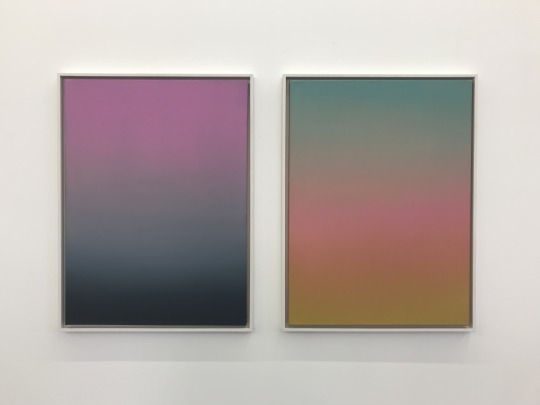
Dorothée Louise Recker, Départ de Vert, 1 (Goutte d’or) and Départ de Noir, 2 (Ash): oil on canvas, 80 x 60 cm, 2018
The newest addition to the Spinnerei is the gallery She BAM! . Its founder Laetitia Gorsy inaugurated the space this past September with the aim to “empower women in the Arts.” The first exhibition with Dorothée Louise Recker (in the main space) and Céline Germès (in the project space) has already set the tone for what we can expect from She Bam! in the future. Recker’s works on display are painted in two distinctive, yet related modes. On the one hand, she has installed and paired atmospheric color field paintings of various sizes. Her colors blend and transition from warm to cold, from green to orange, from pink to black. Her paintings radiate and draw the viewer in. The ever-changing color combinations simulate ebb and flow and suggest a boundless space devoid of concrete forms. From up close, it is refreshing to see that Recker did not use an airbrush or spray paint, but instead applied paint with a brush, moving horizontally across the surface to blend the various colors until they emulsify seamlessly.

Dorothée Louise Recker, En Négatif, 4, 200 x 250cm, work cloth, bleached and dyed, 2018
Other paintings in her show adopt a similar atmospheric sensibility. En Négatif,4 features bleached and dyed cloth with loose, less predictable marks and stains that sit atop an aquatic red-grey background. These paintings are filled with air, they are light, yet they do not lack substance or presence.
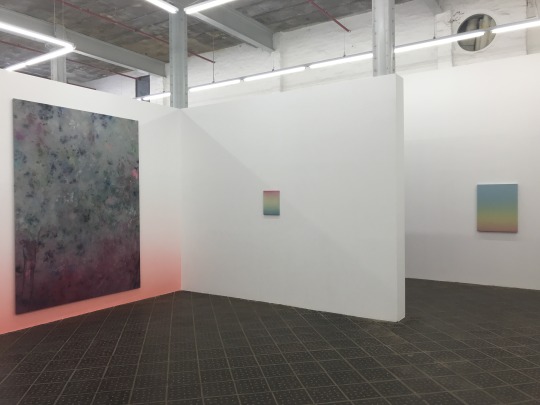
Installation view of Recker’s exhibition
The installation of Recker’s paintings is a work of art in itself and it draws strength from being understated, yet impactful. In several instances, she has painted some of the walls that her paintings are installed on. The paint on these walls, similar to her paintings, has been applied thinly. Her chosen hues are denser toward the gallery floor and turn evanescent once they approach the paintings from below, until they disappear altogether. The effect is one of condensation: evaporating paint that provides an adequate frame for the works on the walls. They no longer just radiate - now they also breathe.
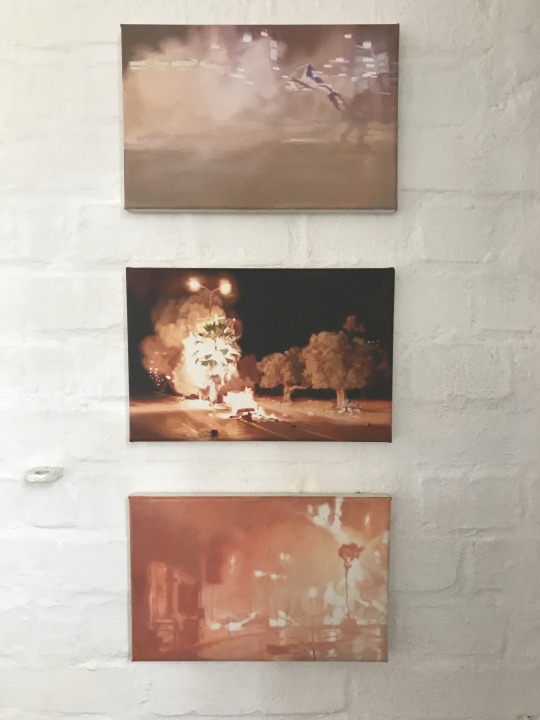
Installation view of Céline Germès’ paintings in the project space
In the project space of the gallery, Germès’ small-scale paintings fill the walls with light, fire and smoke. Her meticulous surfaces reference their digital sources, mainly YouTube videos of riots, demonstrations, scenes of tension and violent eruptions. But they stand their own as paintings and they can only be considered in this way - as tangible, layered objects - precisely because they have been translated into paint. In a digital image, a smoldering fire turns cold the moment it is captured. In Germès’ paintings the same fire transforms into paint made of yellow, red, white and other hues. Her paint is mixed, applied and pushed across the surface to resemble an all-consuming force. In Germès’ paintings the representation of smoke - white and dense or fading and grey - indicates a convergence between paint and a physical phenomenon.

Céline Germès, Street #1, 21 x 32 cm, oil on canvas, 2016
This mastery of material appropriation sets Germès paintings apart from her sources so that the works do not turn into derivative paintings. These paintings acknowledge and emphasize the significance of their source. At the same time, Germès focuses exclusively on source material that demonstrates the reduced visibility of low-resolution footage. Because of her deficient source material, painting steps in as a powerful tool that renders the original image (or sequence of images in a video) less descriptive, more ambiguous and even poetic. It is here that Céline Germès paintings correspond closest to the painterly renditions of Vija Celmins. Both painters take a phenomenon like smoke and turn it into a reflection on seeing, thinking and painting.
Not far from the Spinnerei, approximately a 20 minute walk away, the Handelsschule (German: Trading School) is another hot spot for people working in the creative field. While the building in the back houses the Leipzig School of Design, the three-story building in the front contains artist studios of roughly two dozen artists, workshops, living quarters, and one exhibition space. In typical Leipzig fashion, the art on display ranged from eclectic to highly achieved, including illustrators, designers, photographers, painters, sculptors and one kayak repair shop.

Installation view of paintings on panel in Eva Kaiser’s studio. These paintings are based on her family (including two of her grandfathers in WW2 uniforms) and are part of a larger series called Memento from 2014.
Portraits are mostly on display in Eva Kaiser’s studio. They vary in their handling of color with some painted in shades of grey while others feature stronger contrasts and saturated flesh tones. The degree of resolution of faces and bodies differs as well. Some are schematic and sketched out, while other portraits are more resolved, yet never over-worked.

Installation view of paintings in Kaiser’s studio
(Top: V., 30 x 40 cm, oil on canvas, 2014 and Bottom: L., 30 x 30 cm, oil on canvas, 2014)
Two smaller portraits of women, depicting only their heads, are arranged above one another. Their colors are muted; not quite like in black and white photography, but instead they resemble the appearance of hand-colored photographs. Both sitters display an unnerving and captivating look, a glare of sorts - hard to discern and even harder to confront. In conversation, Kaiser discloses that the women in the paintings are German concentration camp guards (Elisabeth Volkenrath and Hilde Lohbauer) during WW2. Her disclosure about the women’s identity is not a preposterous attempt at making “meaningful” painting. These paintings are not cynical or overambitious. Instead their contemporary looks and slight coloration carries them from the past into the present as if to say: we never left, we have never disappeared; that which made us witnesses and accomplices is still with us and it exists within us all.
In light of recent events of far-right agitators hunting down every non-white person in sight and attacking journalists in Chemnitz (or, to use an American equivalent: Charlottesville, VA last year), Kaiser’s paintings cast a warning. Her subjects’ serenity is misleading. Kaiser’s decision to pick female protagonists is a conscious decision. She hopes that her viewers will be unable to identify her subjects as perpetrators of mass murder; a realization that is further complicated by the roles we traditionally expect women to fulfill.
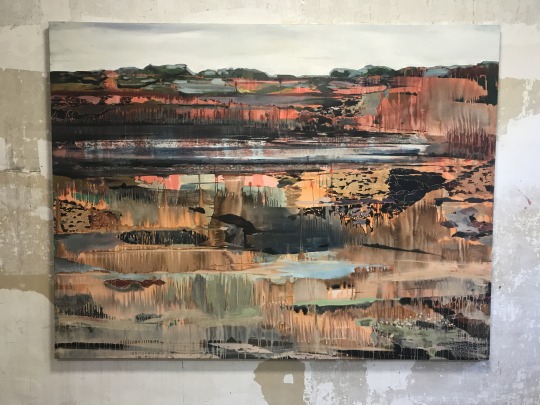
Theresa Möller, Landschaft, 190 x 250 cm, oil and acrylic on canvas, 2018
In Theresa Möller’s studio at the Handelsschule, one painting draws attention away from her other works on display. Partly, this is due to its impressive scale of 75” x 98”. In a general sense, Möller’s most recent works are landscape paintings. The painting in question, simply titled Landschaft (Landscape), is aligned horizontally with a thin sliver of grey separating the “sky” from the “ground”.
Möller’s painting differs from the landscapes of many other painters in the way she employs and tests out a multitude of textures in Landschaft. The horizontal lines and segments that structure her canvas (sometimes more visible, sometimes less so) lend the painting its footing and anchor. Aside from this structuring device, every area in her painting competes with one another, eating and flowing into its neighboring regions and thereby charging the entire work with activity. Even when we start discovering the painting’s many parts and their varied treatment (drips vs. solids, stains vs. shapes, layered vs. wiped), we never lose sight of the whole and its reference to landscape. At the same time, what would become of her painting if the “sky” just disappeared or bled into the rest of the painting? Perhaps Möller wants to uphold this monochromatic element to maintain the illusion of space and with it the belief that the difference between abstraction and figuration is marginal at best.
In the end, the most exciting aspect about these four artists is how their stance toward painting does not add up to four distinct positions. They occupy at least eight positions. Dorothée Louise Recker’s repertoire easily covers abstract and figurative painting (she calls the latter “Figurations”) as well as video. Céline Germès successfully transitions from paintings of fragmented video footage, to photography and back to painting. Both Theresa Möller and Eva Kaiser continue to work through multiple modes of representation by employing the traditional tropes of landscape and portraiture respectively.
One of the most limiting words used to describe a body of work is “uneven.” Detecting unevenness in an artist’s work can be warranted. But to use it as a negative qualifier can be harmful. It can be harmful to the context of an artist’s work and ambition. The presence of “unevenness” does not automatically imply a lack of artistic vision or a lack of discipline. To deny artists “unevenness” is to deny them experimentation. To praise an artist’s “evenness” is to praise the development of a brand or signature style. And the beneficiary of an enduring signature style is an art market that can only turn a profit if it can deliver predictable results.
As these four artists demonstrate, the way forward is to acknowledge that painting is not defined by limitations, but by possibilities. And some of these opportunities demand that we become more curious as artists. They demand that we be aware of our histories, our socio-political conditions, our current times, and the world at large. We will achieve to diversify our practice only if we look for art beyond our studio. Lastly, we need to lose fear of failure. And once we are no longer afraid, we might also stop paying attention to who follows or un-follows us on Instagram.
#Dorothee louise Recker#celine germes#theresa moeller#eva kaiser#leipzig#she bam#laetitia gorsy#spinnerei#leipzig art#contemporary art#handelsschule#open studios#contemporary painting#color field art#history
3 notes
·
View notes
Photo

Pavel Tchelitchew, Inacheve, oil on canvas, 1957
6 notes
·
View notes
Photo

Katrin Heichel: Heim II (Richtfest), oil on canvas, 240 x 190 cm, 2018
6 notes
·
View notes
Photo
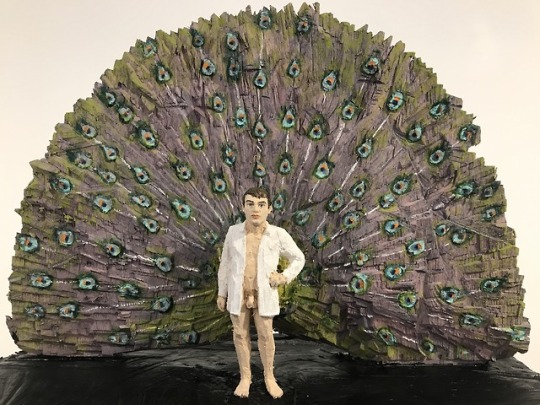
Stephan Balkenhol’s “Peacock” currently at Thaddaeus Ropac gallery in Paris.
4 notes
·
View notes
Photo
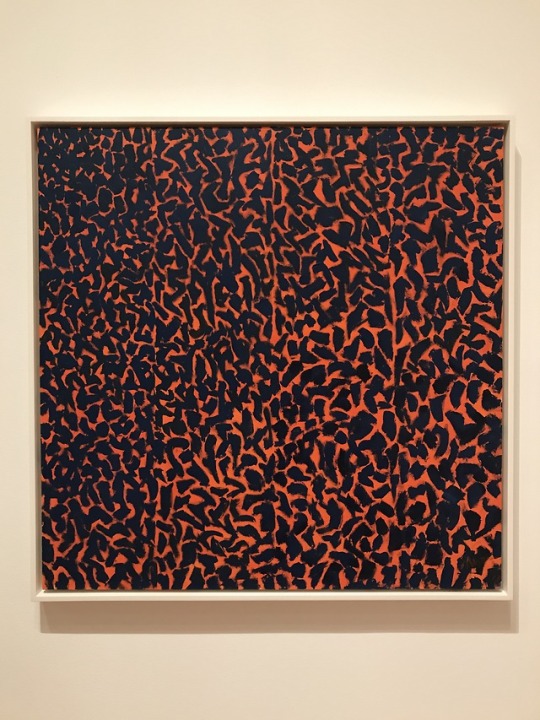
Alma Woodsey Thomas, Fiery Sunset, oil on canvas, 1973
7 notes
·
View notes
Photo

Vilhelm Hammershoi, Moonlight, Strandgade 30, oil on canvas, 1900-1906
#MET#metropolitan museum of art#vilhelm hammershøi#moonlight#interior#painting#mood#atmosperic#paintinglight
2 notes
·
View notes
Text
Leon Golub: A Country No Longer United

Leon Golub, Two Black Women and a White Man, Acrylic on linen, 120″ x 163″, 1986
The background color on the left is made of layered warm tones with light pink, ocher and hints of red. Next to it, on the right side, another wall sets itself apart from the earthen tones of the left side. Here cool colors define the surface: hues of blue, purple and grey. The male white figure is leaning in a relaxed, yet alert manner against the blue wall. His clothing seems to have adopted the colors of the adjacent, ‘warm’ side. But this is where any commonalities between the two sides end.
When the work of Leon Golub is discussed, the most commonly used qualifier appears to be ‘violent’ or ‘violence.’ It is true that many of his works center around the dynamic between violators and their violated. But his means of depicting volatile relationships go beyond showing violent acts; his 1986 painting Two Black Women and a White Man is such an example.
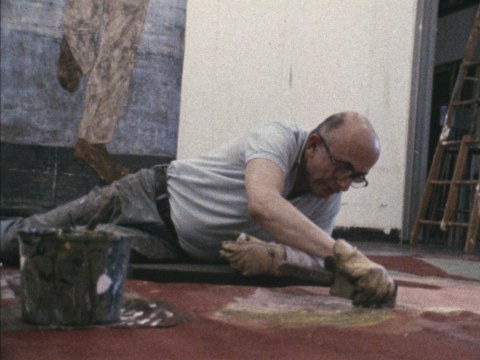
Leon Golub on top of a painting working with a meat cleaver. In the background: Two Black Women and a White Men (source)
Violence comes in different forms and degrees. It is also experienced differently by respective individuals, groups and societies. The clearly marked divide between the white man’s space on the right and the bench with two seated black women on the left delineates racial segregation. Even though all three figures share the same ground, their assigned spaces seem impenetrable, made of lines, marks and contrasting colors that flesh out the realities of segregation. These are the kinds of walls that are imposed, with the sole purpose of exclusion. Golub hints at painterly traditions found in Modernism by treating the background as a flat plane made up of three sections: a square, a rectangle and a narrow dark blue horizontal element that serves as ground and horizon line. His application of paint matters too, because the canvas’ rugged and highly textured appearance is misleading. Golub would often use a meat cleaver to scrape off excess paint instead of letting it build up on the canvas. Aside from his paintings’ washed out, partly transparent although unifying look, the use of a meat cleaver (versus the more conventional palette knife) adds a tool to his repertoire that is usually associated with breaking down bones and meat into smaller, more manageable parts. This tool’s violent potential is repurposed by Golub, yet his canvas surfaces remain marked by the cleaver and its potential to scrape, divide, shatter and kill.
In addition to the formal set-up of this scene in which each figure occupies a space of their own, there are attempts of communication between the two groups. While the bench ends exactly where the white man’s space begins, the woman’s left hand has crossed into his territory. Her hand is at ease, pointing downwards as if to certify her white counterpart that she means no harm. She is looking around her shoulder right at him, trying to meet his gaze, but to no avail. Sensing her attempt, the white man looks the other way. The third figure in this painting, an older black woman and potential companion of the other woman, is looking right at the viewer. If we assume that the white man is intentionally directing his gaze away from these two women, she seems to be asking us not to do the same. As viewers, we become witnesses who are given a choice: either to look the other way or to refuse to do so.
Leon Golub would certainly find many reasons and occasions to make paintings of our current time. He would not feel elevated about that prospect in any way, but he would understand and accept the responsibility to find ways for painting to engage its viewers beyond pictorial references and formalist nodes to past as well as contemporary artists. And to the young painters who have been patient enough to finish reading this post: now is not the time to look the other way.
#leon golub#two black women and a white man#segregation#division#trump administration#art and politics#painting as resistance
3 notes
·
View notes
Photo

Kay Sage, The Answer Is No, oil on canvas, 1958
29 notes
·
View notes
Photo
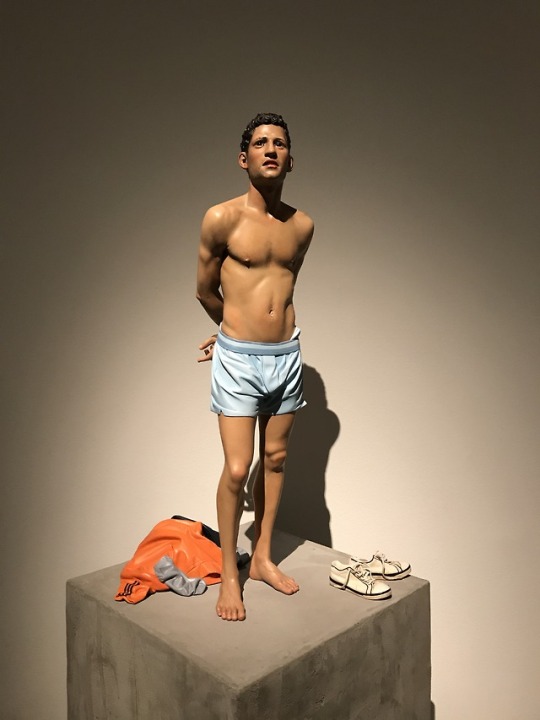
Reza Aramesh, Hand-carved limewood, paint, glass eyes, concrete plinth, 2006:
Palestinian forced to undress at gunpoint by Israeli soldier along the separation barrier at the entrance of Bethlehem, March 2006.
#reza aramesh#sculpture#figurative#figurative sculpture#contemporary art#met breuer#like life#art and politics
2 notes
·
View notes
Photo
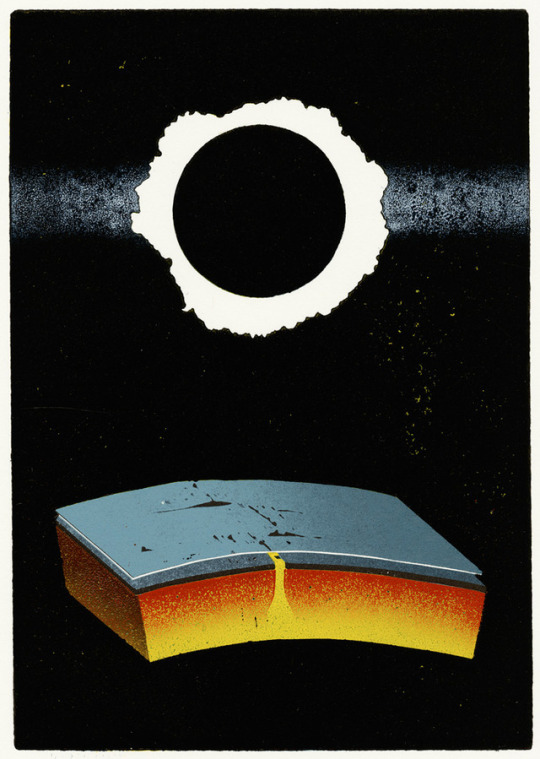
Benjamin Dittrich, Erde (Earth), Linocut, 2013
3 notes
·
View notes
Text
Binelde Hyrcan at GFZK, Leipzig

In Binelde Hyrcan’s 2011 video “Cambeck” at the GFZK (Gallery for Contemporary Art) in Leipzig, the first scene opens with a shot of four kids at play. Each of them is sitting in a dug-out hole by the beach facing the open water. Right before this opening scene, we hear their conversation. It evokes the image of an open top limousine on a slow ride with its guests in the backseat asking their driver to go faster.
Shot in Hyrcan’s home country Angola, which experienced 26 years of civil war from 1975 until 2002, the four kids in the video take on adult personas that express their hopes and fears while simultaneously revealing their parents generation’s unfulfilled ambitions. At one point in the two-and-a-half minute video, one of the backseat protagonists breaks with his role and refers to his father who lives in the US and who will soon welcome his son to join him in a better life. The boy then addresses their “driver”, telling him how he will never be able to leave behind his current situation and that he will eventually end up “in a house made of cans.”

Hyrcan’s video depicts how poverty in a country ravished by colonialism and later by war is re-imagined and acted out by its youngest citizens (It is also worth noting how the boys are testing out adopted norms of masculinity as evident in the hierarchical relationship between the “driver” and his “patrons”.). On the one hand, their imaginary limousine is a familiar trope of children’s play: a device or vehicle that stands for increased mobility, freedom and ultimately agency (like a plane, train, ship, etc.) - all of which remain unattainable. On the other hand, the video’s imaginary car points to a particularly resourceful type of play: with exception of one flip-flop that serves as steering wheel there are no additional material resources (like wood, metal, plastic) that imitate the shape, look or function of a car. The car is not even made from sand; the car is part of the beach and barely distinguishable from it. In this case, the absence of the car is supplemented by these children’s imagination. But the car in absentia also points to a life stripped of resources. This opens up the children’s role play to a double meaning: their desire to imagine what is out of reach or unthinkable and their awareness to reenact the realities of their condition. Binelde Hyrcan’s “Cambeck” is a bitter-sweet testimony to the boundless territory that is children's play and the obstacles created by adults that prove inescapable - even when at play.
5 notes
·
View notes
Text
Open Studios at the Academy of Fine Arts (HGB) Leipzig
About a year into my Visual Arts BA-program in Braunschweig, I heard the words “Leipzig School” for the first time. This was around 2000/2001. At first, it appeared like a rumor - something people would say to point out how artists from the “East” were trying to build a reputation of their own. And by saying so, these “West-German” artists were dismissing a long tradition of Leipzig artists and craftsman that long predated the fall of the Berlin Wall in 1989.
As a Polish-German artist, I had my own share of questionable encounters during this time of transition in the late 1990s and early 2000s. It all culminated in a statement the partner of one of my art professors made: “After all, the Poles do not have an architecture of their own”, meaning that Poland had thankfully “received” architecture from the Germans. When the term “Leipzig School” (or “New Leipzig School”) emerged around that time, it was rejected by many of the Leipzig artists. But its rejection did not dissuade art dealers and artists in the West (and beyond) from using the term to label this exotic, desirable commodity emerging in the East. And the majority of my peers and teachers in Braunschweig did not use the term in a laudable, but in a discriminatory way that proposed an artificial divide between the advanced art of the “West” and the craft-centered, regressive art of the “East”.

Installation shot of Christoph Ruckhäberle’s painting class at the Open Studios
Fast-forward to 2018: The “Leipzig School” no longer needs anybody’s approval or judgement. It has moved passed its outdated label and its definition as a painting-only school. The Academy of Fine Arts Leipzig (Hochschule für Grafik und Buchkunst) is not only well and alive, but it has also been able to outgrow its earlier reputation by simultaneously holding on to its mission to support local artists without compromising its global reach and relevance.
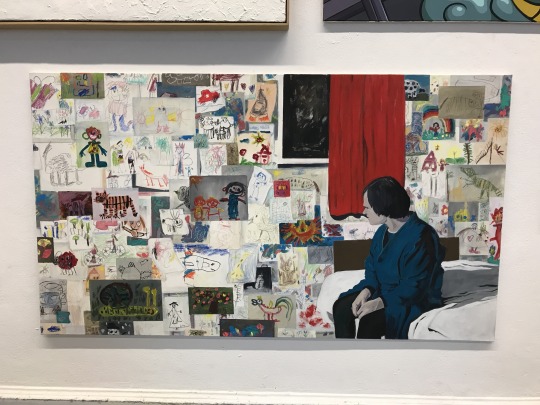
Painting in Ruckhäberle’s class (by Ines Muff)

Painting in Ruckhäberle’s class (by Jooris Klettnig)

Drawing in Ruckhäberle’s class (by Jennifer König)
Painting is still highly visible, but be prepared to be disappointed if you are looking for works that are Neo Rauch or Tim Eitel knock-offs. Many of the painters at the Open Studios have a vision of their own and demonstrate a level of experimentation which rivals their peers’ painting styles in Berlin or New York City. Even though Berlin galleries exhibit work by local artists, the scene there is awash with established international and particularly North American artists (and many of those have ties to NYC). When I refer to the painting “schools” or styles of New York City, a set of artists comes to mind that have had a striking impact on young, emerging New York painters: the figurative work of Nicole Eisenman and Dana Schutz, the whimsical, airbrushed canvases by Austin Lee, more recently the expressive inventions of Katherine Bradford, Amy Sillman’s abstractions, Alice Neel’s portraiture - to just name a few. And for some reason, which might have to do with a long-lasting American love affair with everything European, early twentieth century Expressionism and Modernism is referenced by a significant portion of contemporary NYC and East Coast painters. I yet have to find a similar tendency in contemporary German painting where the ghosts of Vuillard, Matisse, Bonnard, Munch, Morandi, Beckmann and so forth, are evoked with the same fervor.
Any attempt to narrow down a rich and diverse art scene like the one in NYC to one dominant “school” or style is doomed to fail and I lay no claim to a unified style of NYC painting. As the exception proves the rule, NYC has a myriad of artistic exceptions. But many remain underrepresented and their voices are drowned out by the relatively small amount of artists at the top. Seeing the works by young artists at the Leipzig Open Studios was a breath of fresh air - in particular their resistance towards the styles of big-name artists in Leipzig and across Germany’s contemporary art scene. The range from painting, drawing, photography to installation, video and performance was largely of high quality, playful, humorous, critical, inventive, reflective, imaginative, political, high and low brow and everything in between.
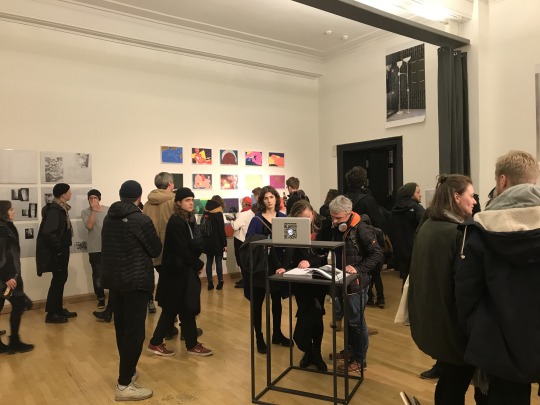



Installation shots of Tobia König’s Risograph prints (Das schöne Geschlecht, 2017)
One of my favorite installations and works were Tobia König’s Risograph prints. They consist of male nudes either engaging in auto-erotic play (the best one, which was hard to photograph, featured a figure sucking its own penis in front of a sun-set lit seascape) or while interacting with animals. From a distance, König’s prints could pass as a variation of Matisse’s paper cuts (I am also drawing this parallel to contradict myself on the relation between contemporary American painters and European Modernism). But from up close, they delight and amuse equally while displaying an array of scenes that range from tender animal-human intimacy to sexually motivated play and self-absorbed, self-sucking gymnastics. And like a sweet cherry on top of a frothy drink sits Tobia König’s title: “Das schöne Geschlecht” - The beautiful gender.
The following images were taken during the Open Studios in both graduate and undergraduate classes. In many cases, the names of the artists were not provided which explains why most of the images below are not labeled. One last observation that I would like to add was the prevalence of drawing (and prints). Traditionally, the Leipzig academy is known for its focus on print and the book/graphic arts. But the wide range of drawing was the most surprising and strongest part of the Open Studios.

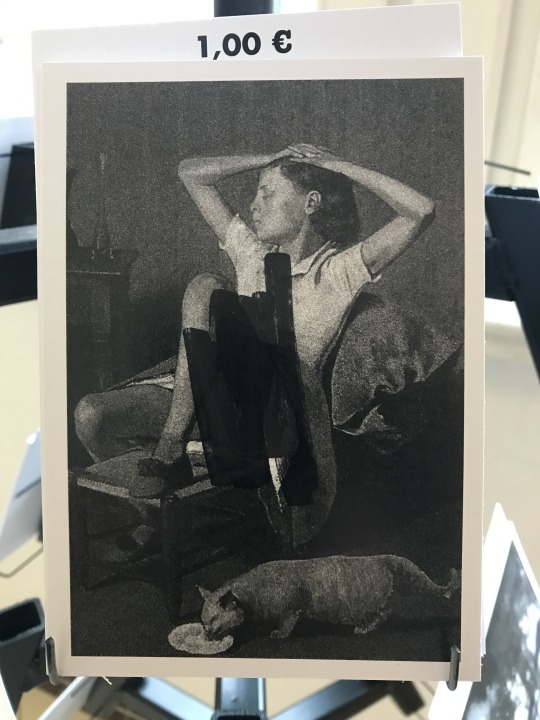
Clara Freund (permanent marker on print)
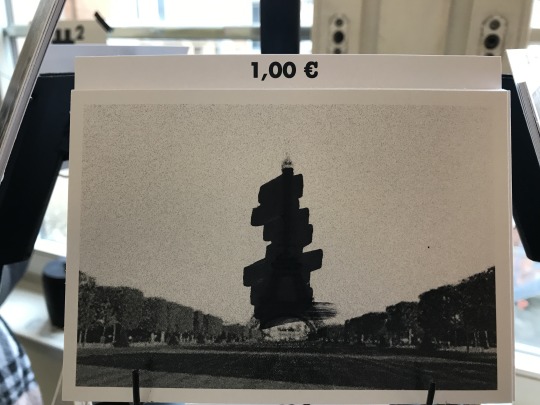
Clara Freund (permanent marker on print)
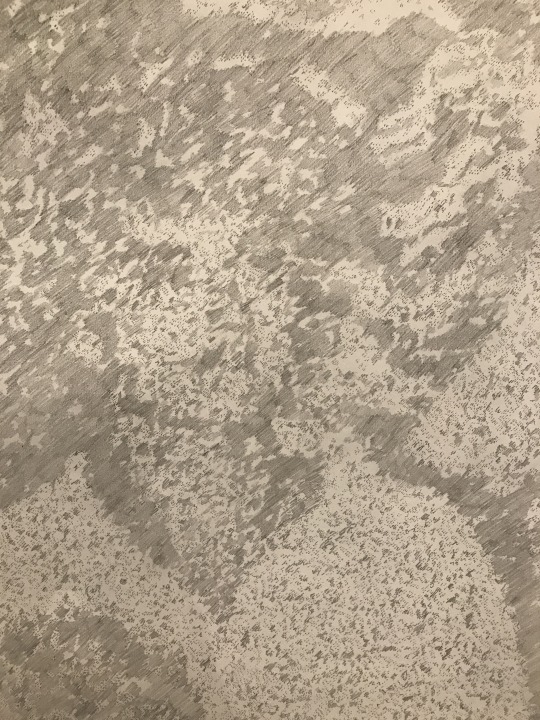




Carina Klinkhammer
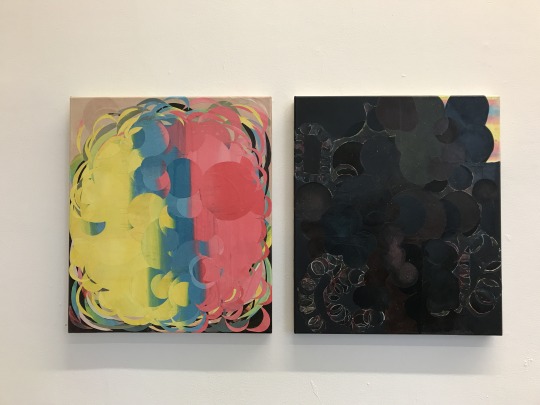


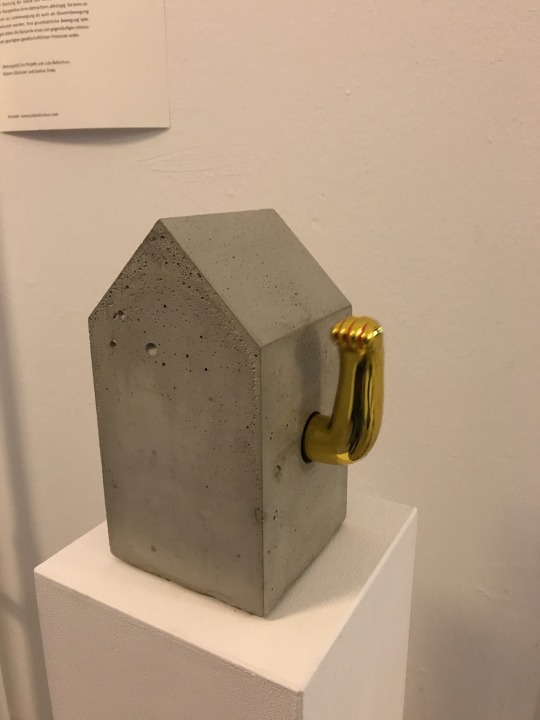
Jula Baltschun, Robert Gloeckner and Soelve Zinke, “Betongold” (Golden Concrete)
#Jula Baltschun#Robert Gloeckner#Soelve Zinke#Rundgang 2018#HGB Leipzig#Leipzig#Academy of Visual Arts Leipzig#Clara Freund#Tobia Koenig#contemporaryart#gegenwartskunst#druckgrafik#malerei#painting#printing#open studios#jennifer könig#jooris klettnig#ines muff
2 notes
·
View notes
Photo

O.T. (no.66), 11″ x 14″, oil on paper, 2018
6 notes
·
View notes